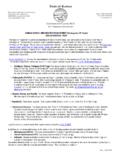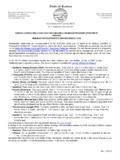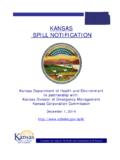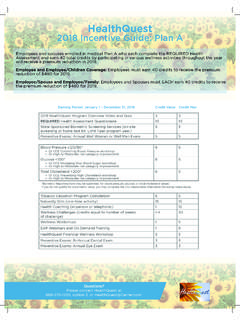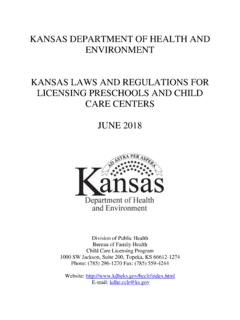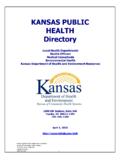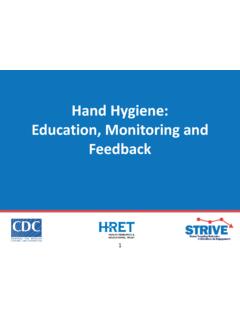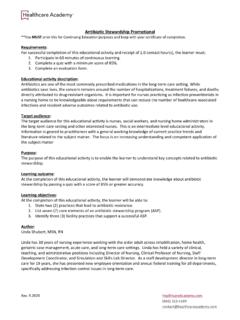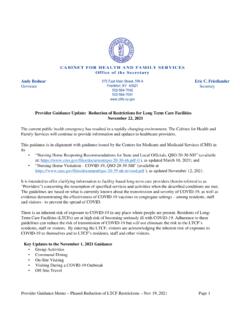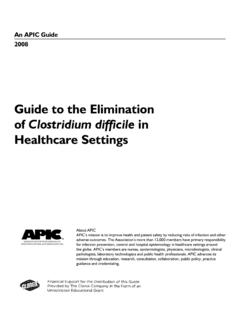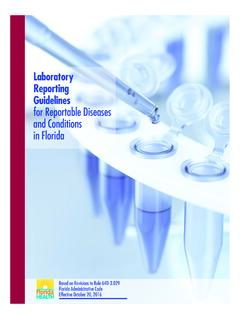Transcription of Antimicrobial Stewardship Programs - KDHE
1 Antimicrobial Stewardship Programsa Toolkit for Critical Access Hospitals in KansasTable of ContentsPageIntroduction3 Aim4 Definitions of Antimicrobial Stewardship4 Summary of Core Elements for Antibiotic Stewardship5 Core Element One: Leadership Commitment6 Examples of Formal Statements of Support6 Sample Mission Statements7 Core Element Two: Accountability9 Key Roles of the Support Team11 Core Element Three: Drug Expertise13 Core Element Four: Actions that Support Optimal Antibiotic Use15 Steps to Developing an ASP16 Strategies and Recommendations for ASPs18 Broad Interventions18 Pharmacy Driven Interventions20 Infection and syndrome specific interventions21 Additional Interventions23 Core Element Five: Tracking and Monitoring Antibiotic Use and Resistance26 Core Element Six: Reporting Information on Improving Antibiotic Use and Resistance28 Core Element Seven: Education30 Kansas Department of Health and Environment 3 IntroductionThe availability of effective antibiotics is one of the most important developments in modern medicine, leading to infectious diseases falling out of the top five leading causes of death in the United States.
2 1 However, continued inappropriate use of antibiotics is contributing to the increased development of antibiotic resistance as well as increased risk of adverse patient outcomes such as Clostridium difficile (C. difficile) and other adverse events. 2, 3, 4, 5, 6, 7 For several decades it has been recognized that up to 50% of antibiotic use was inappropriate- meaning there was no infection, the wrong antibiotic was prescribed, or the duration of treatment was incorrect. 8 According to the Centers for Disease Control and Prevention (CDC) ..at least 2 million people become infected with bacteria that are resistant to antibiotics and at least 23,000 people die each year as a direct result of these infections . 4 Improper use and over prescribing are two of the many factors surrounding antibiotic resistance that are of great importance to the healthcare community, because these are the two areas where we can work to make improvements.
3 When prescribing antibiotics the benefits need to be weighed against the possible risks associated with increased resistance and adverse health outcomes. The best way to begin to combat this issue to is to start with the implementation of Antimicrobial Stewardship Programs (ASPs) in hospitals. An Antimicrobial Stewardship program can provide specific policies for an institution to address antibiotic prescribing and implement tracking systems to monitor rates of infection and resistance patterns within their facility. 9In 2014, the CDC recommended that all acute care hospitals implement antibiotic Stewardship Programs in order to meet the urgent need to improve antibiotic use in hospitals. 10 This toolkit follows the CDC s Core Elements of Antimicrobial Stewardship and adapts these core elements to facilities in the state of Kansas, in particular the critical access hospitals and provides specific examples in order to better aid hospitals in the development and implementation of effective : Centers for Disease Control and Prevention Publich Health Image Library4 Kansas Department of Health and EnvironmentAssociation for Professionals in Infection Control and Epidemiology Antimicrobial Stewardship is a coordinated program that promotes the appropriate use of antimicrobials (including antibiotics), improves patient outcomes, reduces microbial resistance, and decreases the spread of infections caused by multidrug-resistant organisms.
4 AimThe aim of this toolkit is to provide an evidence-based outline for Antimicrobial Stewardship Programs in the acute care of Antimicrobial StewardshipCenters for Disease Control and Prevention Antimicrobial Stewardship refers to a set of commitments and activities designed to optimize the treatment of infections while reducing the adverse events associated with antibiotic use. Infectious Diseases Society of America Antimicrobial Stewardship refers to coordinated interventions designed to improve and measure the appropriate use of antimicrobials by promoting the selection of the optimal Antimicrobial drug regimen, dose, duration of therapy, and route of administration. Antimicrobial stewards seek to achieve optimal clinical outcomes related to Antimicrobial use, minimize toxicity and other adverse events, reduce the costs of health care for infections , and limit the selection for Antimicrobial resistant strains.
5 Kansas Department of Health and Environment 5 Summary of Core Elements for Antimicrobial StewardshipSource: Centers for Disease Control and Prevention6 Kansas Department of Health and EnvironmentCore Element 1: Leadership CommitmentClear support from leadership is vital for the success of an Antimicrobial Stewardship program. Leadership commitment can come in the form of financial support, written statements of support, or dedicated time and resource allocation. 9, 11 Communicating regularly with leadership on the importance of Antimicrobial Stewardship and directing leadership towards CDC s Get Smart for Healthcare may aid in gaining support from leadership. Studies conducted by CDC using data from the National Healthcare Safety Network (NHSN), as well as local surveys on Antimicrobial Stewardship practices in Kansas show that support from leadership is the greatest predictor of whether or not a facility has an ASP.
6 12 Providing not only information on the importance of ASP in healthcare, leadership may also wish to understand the business case for the ASP. With thin margins hospitals must do more with less money and on their most basic level ASPs can decrease the number of C. difficile and multi-drug resistant organism infections which can lead to decreased costs as well as increased patient satisfaction and a better reputation for the facility. 13 Many key national reports also highlight the importance of ASPs and may help when speaking with of formal statements of supportHenry Ford Health System will ensure appropriate Antimicrobial use throughout its health system. By 2017, the health system will implement the CDC core elements for antibiotic Stewardship Programs and aim to make the following improvements: implementing a 72-hour time-out for intravenous antimicrobials; Source: Centers for Disease Control and Prevention Publich Health Image LibraryKansas Department of Health and Environment 7implementing a smart stop date in EMR systems reflecting best available evidence on duration of therapy; participating in NHSN reporting of Antimicrobial utilization; integrating Antimicrobial Stewardship goals in outpatient prescribing for patients seen in its emergency departments and clinics.
7 And implementing transition of care Programs to improve the quality and safety of Outpatient Parenteral Antimicrobial Therapy across the health Hopkins Medicine will have Antibiotic Stewardship Programs (ASP) in all of its hospitals over the next two years by implementing and sustaining activities that include all sites reporting data to the NHSN AUR module and agreeing upon, disseminating Johns Hopkins Medicine guidelines for antibiotic use, and developing, executing, and reporting targeted interventions to improve antibiotic examples of Leaders Committed to Antibiotic Stewardship mission statementsSaint Luke s Health SystemTo achieve the best possible Antimicrobial related outcomes across the Saint Luke s Health System by ensuring the optimal selection, dose, and duration of antimicrobials for treatment or prevention while minimizing the impact of possible side effects and Antimicrobial County Hospital Health SystemThe primary mission of antibiotic Stewardship is to promote optimal antibiotic therapy in order to improve patient safety at Mitchell County Hospital Health System.
8 John s Hopkins The mission of the program is to ensure that every patient at Hopkins on antibiotics gets optimal therapy. Our goal is for the Antimicrobial Stewardship Program to be a useful service in optimizing antibiotic use at Barton HospitalThe Antimicrobial Stewardship program at Clara Barton Hospital and medical clinics will optimize the utilization of Antimicrobial agents in order to achieve improved patient outcomes, a positive effect on Antimicrobial resistance, and an economic Kansas Department of Health and EnvironmentResourcesThe Society for Healthcare Epidemiology of America Making the Business Case for Antimicrobial Stewardship Programs : Taking it to the C-Suite Hospital Association Physician Leadership Forum on Antimicrobial Stewardship Disease Society of America Promoting Antimicrobial Stewardship in Human Medicine President s Council of Advisors on Science and Technology Report to the President of the United States on Combating Antibiotic Resistance President s National Action Plan for Combating Antibiotic-Resistant Bacteria Actions of Leadership Leadership should provide formal written statements that the facility supports efforts to improve and monitor antibiotic use.
9 Formal statements carry more weight with staff than informal communications such as newsletters and e-mail. 11 Leadership should provide either financial support or time allocation or both for Stewardship activities including education and training. Stewardship -related duties in job descriptions and annual performance reviews can be used to accomplish this. 11 Leadership should ensure adequate staffing for ASP activities in relevant departments in order to provide sufficient time to contribute to Stewardship activities. 11 Leadership should ensure participation from the many groups that can support Stewardship activities. 9 Leadership should establish clear communication on Antimicrobial Stewardship strategies. 11 Kansas Department of Health and Environment 9 Core Element 2: AccountabilityAll facilities should identify individuals who are accountable for antibiotic Stewardship activities as well as those who also have support of leadership within the facility.
10 Establishing an ASP TeamAn important first step in the development of an ASP is the development of the team as well as the appointment of a leader of the Antimicrobial Stewardship team. The IDSA recommends core members of the team to include an infectious disease physician as well as a clinical pharmacist with infectious disease training. 8 In smaller hospitals it may be useful to find other physician champions such as hospitalist, or other part time or off site expertise when infectious disease doctors are not available in house. 14, 15, 16 Antimicrobial Stewardship is an important component of patient safety and is therefore considered to be a medical staff function, empowering the medical director to set prescribing standards as well as empowering the director of nursing to set practice standards can have great impacts for Antimicrobial Stewardship . 8, 17 In addition to having a team with the appropriate core members it is also important to any ASP to have adequate support from leadership.

